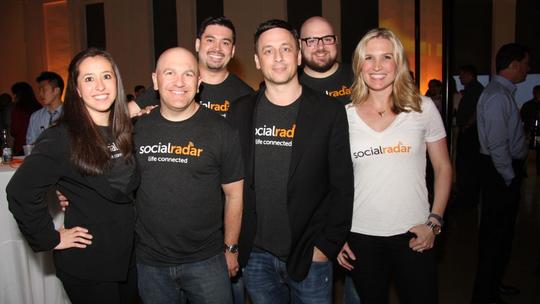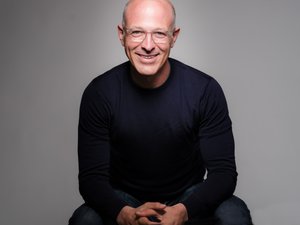

Founded in 2013 and supported by a $12.75 million Series A funding round from some of the biggest local names in venture capital, SocialRadar quickly became a darling of the D.C. tech scene with its location-based social app. It also didn't hurt that the company was led by the former CEO of Blackboard, Michael Chasen.
Flattering opinions, however, can change just as quickly.
To some, SocialRadar’s national profile in 2013 became a hopeful embodiment of D.C.’s own rising technology economy. Yet in recent months, SocialRadar pivoted to become a provider of location technology SDK, even as chief marketing officer Kevin Alansky and the team behind Gridskippr—acquired by SocialRadar months prior—moved on to other ventures. Then there were the staff cutbacks that we learned of recently.
What's the deal? Is SocialRadar's future really in doubt?
Capturing a truly special moment, @powellarts snaps a photo of the @SocialRadarApp team at #srlaunch. #dctech pic.twitter.com/UxFDQTCg3M
— Shana Glenzer (@ShanaGlenzer) February 28, 2014
In an interview with DC Inno, Chasen said no, SocialRadar isn't going anywhere. And Alansky also offered insights that give more context to what's happening at the company. “People were expecting us to be Tinder overnight,” Alansky told DC Inno.
Here are five key things we've learned about the company, offering detailed information into what is happening on the ground at the still-young company:
1.) Gridskippr
As mentioned, SocialRadar pivoted hard earlier this year, away from a consumer app, and toward become a location-tech software development kit (SDK) provider. But the decision to step away from the mobile app sphere actually came much earlier, as they acquired Baltimore-based location tech startup Gridskippr in November to fulfill the development needs necessary to pull it off.
In June, the three-person Gridskippr team left SocialRadar to establish Parkour, another based mapping tech SDK provider.
Chasen and Gridskippr CEO Yonis Benitez told DC Inno that they had come to a mutual agreement when the Gridskippr acquisition closed that the team would be moving on after it developed a series of products. In short, Benitez’s team did not move on because of either the health or financial stability of the company.
Chasen currently offers advice and mentorship to Benitez, in a relationship that Benitez described as “very helpful.”
2.) Turnover and layoffs
Prior to the Parkour “migration,” lead Android engineers Andy Lawton, Jay Brendon Bobzin and a few other developers moved on to new positions with other companies. A series of layoffs also occurred in the fall of 2014. While each departure occurred for a different set of reasons, both Chasen and Alansky told DC Inno that SocialRadar’s developers were constantly receiving attention and getting poached by larger consumer tech companies.
yep, this is the line to get into #srlaunch party tonight at @1776dc. Great to see DC come to celebrate the launch! pic.twitter.com/o35nOhCrKz
— Donna Harris (@dharrisindc) February 28, 2014
The inquiries continued because of the market demand for developers with the specific skill set needed to build out a location-centric consumer app, Chasen and Alansky said.
Over the course of the last several months, there’s been an obvious display of mapping/location tech startup funding and consolidation as this demand, which continues to grow. For instance, D.C.-based Mapbox, maker of a mapping platform for developers, raised an impressive $52.6 million Series C.
"People were expecting us to be Tinder overnight."
After reportedly attempting to acquire Nokia's Here mapping business for several billion, Uber took advantage of Microsoft’s tumultuous cutbacks to scoop Bing Maps’ developers. At the time, the company declined to comment but many observers believed the move was made to make Uber’s mapping data more accurate—enabling pinpoint location pickups and improvement within pilot product UberPool.
Bobzin currently works for Uber, Lawton received an offer from Airbnb but is now currently working as a consultant with iStrategy Labs.
Alansky also told DC Inno, without naming specific former employees, that there were a few developers that just “didn’t fit,” resulting in additional turnover. “I don’t believe we had an abnormal amount of turnover. The fact is, with a small team it looks worse than in other situations.”
As for Alansky’s departure, his decision to leave the company and join Vienna-based CRM software developer CircleBack came over time—as did the pivot—and was amicably coordinated between himself and Chasen. It was also largely influenced by the company’s shifting directive and its need to hire a marketing executive with experience marketing a product sold directly to developers.
3.) Financials
We've heard reports from multiple people with connections to the company that SocialRadar may not be far from running short of funding. But Chasen said that's not the case. Alansky and Benitez also said that, to the best of their knowledge, there isn't an imminent shortfall on money at SocialRadar (though they cautioned that it had been several months since they'd been privy to the details). Chasen said the company won't need to raise additional funding for another 10-12 months, and he's confident SocialRadar will be in a position to do that when the time comes.
The pivot toward becoming a mapping tech SDK provider shows promise. The market for mapping tech startups is hot, as we noted earlier, and just about every popular mobile app uses some form of location technology to enhance user experience, today.
4.) Why the consumer app failed
One of the main reasons that SocialRadar’s consumer app didn’t pan out is because user acquisition costs continued to rise unpredictably throughout the development process, Alansky and Chasen both explained.
“It’s in the eye of the beholder, really. We raised a ton of money, so lots of eyes were on us from day one. The fact that Michael was going into this company, and raising money, and with his profile, it became a big deal… Yes, we faced challenges with the consumer app. Some out of it was in our control and some not,” Alansky said.

Facebook played a major role in forcing the rising user acquisition cost for SocialRadar. Alansky said Facebook’s app advertising platform had “skyrocketed,” with prices spiking during the development process. It became more and more costly to reach their target advertisement demographic.
As time progressed, Facebook also became the dominant player in the mobile app ad realm, beating competitors like Twitter, Yahoo, Pinterest and even Google. Last year, Facebook stunned investor when it announced during its Q1 earnings report that mobile app ad business accounted for nearly 60 percent of total ad revenue during the quarter.
Currently, for very targeted mobile ads, some companies are willing to pay as much as $8, $10 or $20 per Facebook ad, The Wall Street Journal reports. Nearing the pivot, SocialRadar’s advertising costs reached $7-10 per user downloaded.
When SocialRadar first began advertising via Facebook the cost was about $1 per successful user download to reach the demographic they were targeting. Costs were low, funding was flush and attracting users appeared almost predestined.
From an early stage, Facebook was accepted to be this catalyst used to drive SocialRadar’s growth, reach users and in the end, it undoubtedly helped determine the fate of the social app.
“This is big business. Our company is spending many millions a month on mobile app install ads for clients,” Craig Palli, chief strategy officer at the mobile app marketing company Fiksu, told The Wall Street Journal in April 2014.
“It simply outpaced what we could afford,” Alansky said.
5.) Future potential
In the mapping tech space, it’s unlike other industries in that the product standard is clear, definable and serves as a benchmark for success. Company’s location-finding technology must be able to compete with Apple and Google in terms of global positioning system (GPS) data accuracy.
Facebook played a major role in forcing the rising user acquisition cost for SocialRadar
In its new developer kit, SocialRadar’s location technology uses more than GPS, however, it also taps into a smartphone’s accelerometer, magnetometer, nearby Wi-Fi, Bluetooth and its compass while operating on “low battery drain.” In addition, developers will be able to intertwine a location analytics dashboard into mobile apps for business owners to overview.
The current SocialRadar location SDK is free for developers to use but the company plans to eventually offer an upgraded/premium version of it, Chasen told us, that will include customer service options and other features. The idea is to benefit from licensing and other royalty fees as more developers pick it up.

Apple and Google offer closed-source mapping technology, but if you can create a product that either emulates or exceeds it’s mobile location accuracy then you’re golden, Alansky said, referring to SocialRadar’s pivot.
What Alansky is referring to, more specifically, is something called automatic venue detection—a situation where, for example, one could enter a Starbucks and have a prompt appear from a smartphone that provides things like location-specific coupons, specials and previously favorited menu options.

At the moment, applications and retailers are finding it difficult to execute these sorts of promotional location-based advertisement strategies because of mobile accuracy concerns.
The technology is still catching up, but companies like SocialRadar want to bridge this gap. “The business opportunity for those that can make smartphones effectively responsive to user’s environment and situation, is incredible. And I believe its becoming more and more important in the overall smartphone tech landscape,” Chasen told DC Inno.




